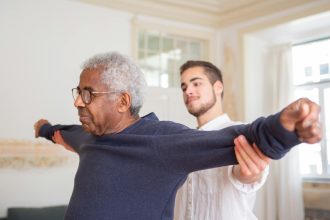After a brain injury, the most visible wounds often heal first. What can linger — and prove most challenging — are the unseen changes in how a person thinks, feels, and behaves. These cognitive and behavioral effects can alter memory, focus, reasoning, and emotional control, reshaping relationships and daily life long after physical recovery.
- The Brain’s Role in Cognition and Behavior
- Common Cognitive Changes
- Behavioral and Emotional Changes
- How These Changes Affect Daily Life
- Assessment and Rehabilitation
- 1. Cognitive Rehabilitation Therapy
- 2. Behavioral and Emotional Support
- 3. Family Education and Support
- 4. Environmental Adaptation
- Recovery and Outlook
- Key Takeaway
Understanding these changes is essential not only for patients, but for families and caregivers who support them.
The Brain’s Role in Cognition and Behavior
Every part of the brain contributes to who we are and how we act.
When injury disrupts these networks, even subtle damage can have lasting effects.
- Frontal lobes regulate judgment, impulse control, and social behavior.
- Temporal lobes handle memory, comprehension, and emotional recognition.
- Parietal lobes guide attention and spatial awareness.
- Limbic structures influence mood and motivation.
The result of injury to any of these areas can be profound—leading to difficulties with concentration, communication, or emotional balance.
Common Cognitive Changes
Cognitive symptoms can appear immediately or emerge over time as the brain heals. Their severity often depends on the injury’s location and depth.
Typical challenges include:
- Attention and concentration: Trouble staying focused or shifting between tasks.
- Memory problems: Forgetting recent events, conversations, or instructions.
- Processing speed: Slower thinking, especially when multitasking.
- Executive function deficits: Difficulty planning, organizing, or making decisions.
- Language and communication issues: Finding words, following conversations, or understanding complex information.
People often describe feeling mentally “foggy” or easily overwhelmed, especially in noisy or fast-paced settings.
Behavioral and Emotional Changes
In addition to cognitive symptoms, many experience shifts in personality and emotional response. These can be among the most distressing aspects of recovery.
Common behavioral and emotional effects:
- Irritability or short temper
- Impulsivity or poor judgment
- Apathy or reduced motivation
- Depression or anxiety
- Mood swings or emotional lability
- Social inappropriateness or lack of inhibition
These changes do not reflect “who the person has become,” but rather how the brain’s circuits for self-control and emotion have been altered. With time and therapy, many patients regain greater stability and self-awareness.
How These Changes Affect Daily Life
Cognitive and behavioral effects ripple across every aspect of living:
- Work or school performance may decline.
- Relationships can become strained by misunderstanding or frustration.
- Everyday routines—paying bills, cooking, remembering appointments—can feel overwhelming.
For families, recognizing that these behaviors stem from injury, not intent, is key to maintaining empathy and patience.
Assessment and Rehabilitation
Neuropsychological testing is often the first step in identifying specific deficits. From there, a multidisciplinary team tailors rehabilitation to the individual’s needs.
1. Cognitive Rehabilitation Therapy
Structured exercises rebuild attention, memory, and problem-solving skills. Therapists teach compensatory strategies, such as using planners, reminders, or visual cues.
2. Behavioral and Emotional Support
Counseling, neuropsychology sessions, and medications can help regulate mood and impulse control. Cognitive-behavioral therapy (CBT) and mindfulness techniques often improve coping and self-awareness.
3. Family Education and Support
Caregivers learn communication strategies, behavior management techniques, and ways to set realistic expectations during recovery.
4. Environmental Adaptation
Simplifying routines, reducing distractions, and maintaining consistent schedules help minimize frustration and confusion.
Recovery and Outlook
While some cognitive and behavioral effects improve within months, others persist or evolve over years.
Recovery depends on the brain’s plasticity—the ability to form new neural connections—and the quality of rehabilitation support.
Encouragingly, many people regain independence and emotional stability with persistence, structured therapy, and compassionate support systems.
Key Takeaway
Cognitive and behavioral changes are among the most life-altering consequences of brain injury, but they are also among the most responsive to rehabilitation.
With early intervention, patience, and ongoing education, individuals and families can adapt, recover, and rebuild meaningful lives after injury.





